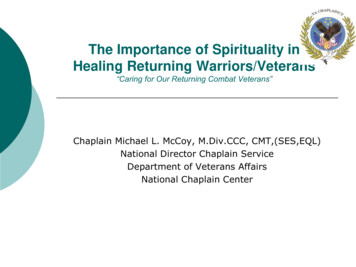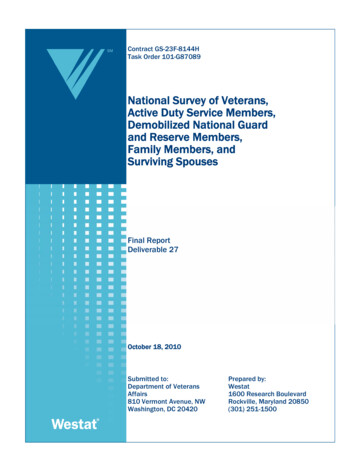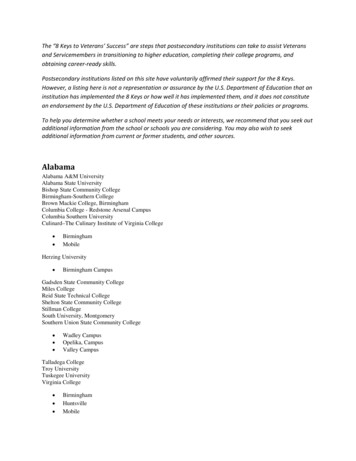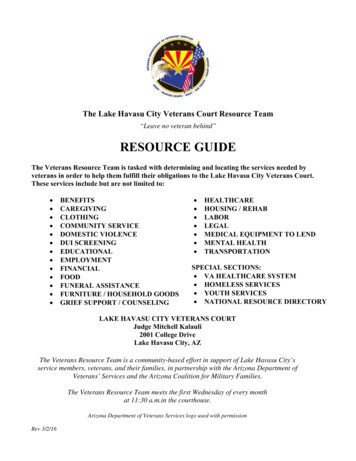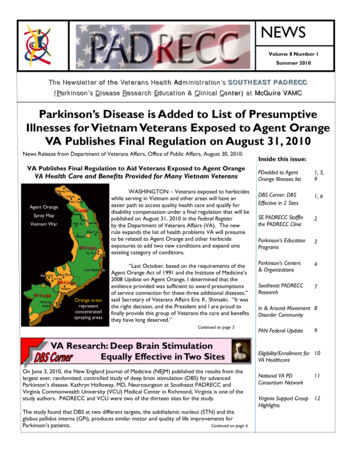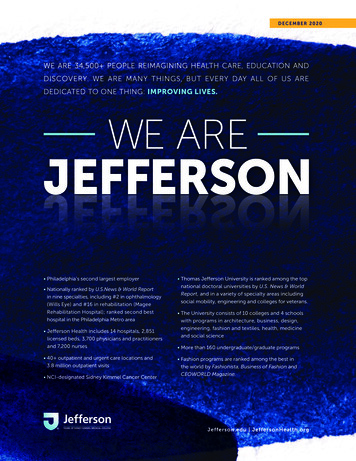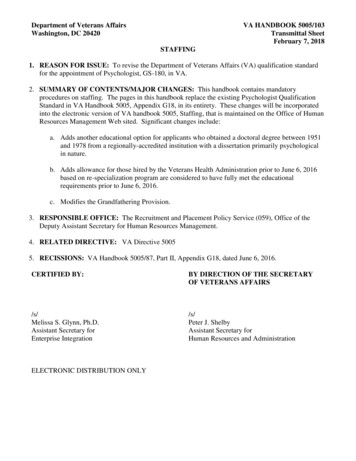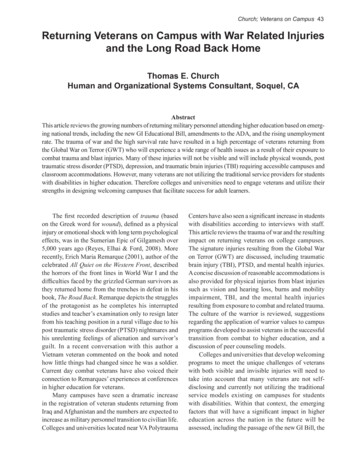
Transcription
Church; Veterans on Campus 43Returning Veterans on Campus with War Related Injuriesand the Long Road Back HomeThomas E. ChurchHuman and Organizational Systems Consultant, Soquel, CAAbstractThis article reviews the growing numbers of returning military personnel attending higher education based on emerging national trends, including the new GI Educational Bill, amendments to the ADA, and the rising unemploymentrate. The trauma of war and the high survival rate have resulted in a high percentage of veterans returning fromthe Global War on Terror (GWT) who will experience a wide range of health issues as a result of their exposure tocombat trauma and blast injuries. Many of these injuries will not be visible and will include physical wounds, posttraumatic stress disorder (PTSD), depression, and traumatic brain injuries (TBI) requiring accessible campuses andclassroom accommodations. However, many veterans are not utilizing the traditional service providers for studentswith disabilities in higher education. Therefore colleges and universities need to engage veterans and utilize theirstrengths in designing welcoming campuses that facilitate success for adult learners.The first recorded description of trauma (basedon the Greek word for wound), defined as a physicalinjury or emotional shock with long term psychologicaleffects, was in the Sumerian Epic of Gilgamesh over5,000 years ago (Reyes, Elhai & Ford, 2008). Morerecently, Erich Maria Remarque (2001), author of thecelebrated All Quiet on the Western Front, describedthe horrors of the front lines in World War I and thedifficulties faced by the grizzled German survivors asthey returned home from the trenches in defeat in hisbook, The Road Back. Remarque depicts the strugglesof the protagonist as he completes his interruptedstudies and teacher’s examination only to resign laterfrom his teaching position in a rural village due to hispost traumatic stress disorder (PTSD) nightmares andhis unrelenting feelings of alienation and survivor’sguilt. In a recent conversation with this author aVietnam veteran commented on the book and notedhow little things had changed since he was a soldier.Current day combat veterans have also voiced theirconnection to Remarques’ experiences at conferencesin higher education for veterans.Many campuses have seen a dramatic increasein the registration of veteran students returning fromIraq and Afghanistan and the numbers are expected toincrease as military personnel transition to civilian life.Colleges and universities located near VA PolytraumaCenters have also seen a significant increase in studentswith disabilities according to interviews with staff.This article reviews the trauma of war and the resultingimpact on returning veterans on college campuses.The signature injuries resulting from the Global Waron Terror (GWT) are discussed, including traumaticbrain injury (TBI), PTSD, and mental health injuries.A concise discussion of reasonable accommodations isalso provided for physical injuries from blast injuriessuch as vision and hearing loss, burns and mobilityimpairment, TBI, and the mental health injuriesresulting from exposure to combat and related trauma.The culture of the warrior is reviewed, suggestionsregarding the application of warrior values to campusprograms developed to assist veterans in the successfultransition from combat to higher education, and adiscussion of peer counseling models.Colleges and universities that develop welcomingprograms to meet the unique challenges of veteranswith both visible and invisible injuries will need totake into account that many veterans are not selfdisclosing and currently not utilizing the traditionalservice models existing on campuses for studentswith disabilities. Within that context, the emergingfactors that will have a significant impact in highereducation across the nation in the future will beassessed, including the passage of the new GI Bill, the
44 Journal of Postsecondary Education and Disability, Vol. 22, No. 1; 2009Americans with Disabilities Amendment Act (ADAA),and an economy in recession. This information will bediscussed and recommendations made for campuses toincorporate into their action plans.Statistics Related to the Global War on TerrorThe number of troops deployed in the GWT isestimated at 1.8 to 2.1 million. However, this numberis difficult to estimate and may increase due to abuildup of US troops in Afghanistan. The length oftours has been extended, and military personnel thatserve multiple tours have increased chances of injury.The length of the war is also a factor that is impossibleto predict, although the “anticipated deadline for Iraqis 2012” (Yacoub, Salaheddin, & Abdul-Kadir, 2008).Out of the above troops, an estimated 712,800 to840,000 veterans are predicted to eventually apply fordisability benefits (Stiglitz & Bilmes, 2008). Vietnamera and Gulf War veterans are still applying for PTSDtreatment and disability benefits demonstrating theincreasing numbers of veterans receiving disabilitybenefits as the population ages (Stiglitz & Bilmes,2008).Signature Injuries from the Global War on TerrorSoldiers are more likely to sustain injuries thanto die as they did in past wars based on the ratioof injuries to deaths. Medical advancements andimproved equipment, especially protective body armor,contribute to the improved survival rate. The ratio ofinjuries to deaths in this war is much higher (16/1)than in previous wars due to the use of armor and rapidevacuation from the battlefield. Department of Defensestatistics (Bilmes, 2007) estimated a total of 50,500injuries, including 20% involving the spinal cordor the brain and 18% experiencing serious wounds.The number of amputations (roughly 6%) alreadyexceeds the number from the Vietnam War. Many ofthese students will require campuses that meet ADArequirements and colleges and universities need toreview and update their ADA/504 evaluations on anongoing basis.There are three major types of injuries or traumaexperienced by veterans of the GWT: physical injuriesfrom blasts such as burns, amputations and orthopedicinjuries; operational stress injuries and mental healthinjuries; and TBI. Blasts are considered the signaturecause of injuries in the GWT from ImprovisedExplosive Devices (IEDs). Soldiers are exposed to avariety of stressful events including combat and theCTI-104 (Comprehensive Trauma Inventory) lists 104specific traumatic types of exposure to war conditions(Ford, 2008).Many factors will impact soldiers’ response to theirexperiences in the war zone. Witnessing violence anddeath have been demonstrated to increase risk for angerand aggressive behavior, anxiety, somatic complaintsand, PTSD. The veterans’ reaction will range fromhigh levels of PTSD and functional impairment tothose who grow and mature from the experiences.Past experience has demonstrated that most returningsoldiers become productive citizens, while for othersmental-health issues remain a significant public healthproblem. For example, veterans with PTSD oftenwrestle with income disparities and unemployment,relationship issues, and aggressive behavior (Stiglitz& Bilmes, 2008).Returning veterans will have a wide range of medicaldiagnoses and related health problems that will have atemporary or chronic impact on their living, working,learning, and relationship functions. The availability of aveteran’s personal, family and/or community resourceswill mitigate their experience with a health problem.These conditions may have a significant impact on theindividual’s strength, endurance and energy levels, andif they are taking medication then there may also besignificant side effects.It is impossible to generalize about the functionalabilities or limitations of combat veterans dueto the wide range of disabilities, diagnoses, andcontributing factors. Table 1 lists some of the possiblemanifestations that may be experienced individuallyor in comorbidity by combat veterans in the highereducation environment. Many of these will alreadybe familiar manifestations to service providers whowork with students with disabilities. It is importantfor Disability Service (DS) providers and other highereducation professionals to be aware that the followingconditions may be common to veterans with any typeof disability: unpredictable attendance due to pain orother symptoms, scheduled absences due to requiredtravel to VA facilities for medical care, and medicationrelated issues that impair performance.Traumatic Brain InjuriesBlast injuries sustained in combat come fromgrenades, bombs, missiles, mortars, and artilleryshells. The blasts alter the cells’ metabolism and result
Church; Veterans on Campus 45Table 1Common Manifestations of Various Disabilities from the GWTManifestations of Spinal Cord Injuries or AmputationsInterference with physical dexterity to complete laboratory, computer or writing assignmentsDifficulty with prolonged sitting or standing at a lab tableMobility challenges to and from the classroom and other activitiesManifestations of Sensory ImpairmentsDifficulty hearing lecture, discussion or advising sessions, etcDifficulty seeing the board, reading course materials, creating written assignmentsDifficulty accessing the course web site or electronic resourcesLack of traditional means of accommodation (American sign language, Braille, for example) due toacquired naturein eventual cell death, although there may not be anyvisible signs of injury. Blast injuries create a pressurewave, which affects organs that are air filled, such asthe ears and lungs, and those surrounded by fluid filledcavities, such as the brain and the spine. This eventuallyleads to brain cell death and traumatic brain injuries inaddition to possible injuries from impact from debris,burns, and exposure to gases and vapors. TBI resultsfrom deceleration forces and blunt or penetratingtrauma, that may lead to functional impairments. Dueto the brain’s complexity, the consequences vary, andtreatment is specific to the individual (Defense andBrain Injuries Center, 2008). Approximately 43%of the veterans returning from the GWT have beenevaluated for TBI (Kaplan, 2008). Seven percentreported TBI combined with symptoms of depressionor PTSD. Table 2 contains a list of key functionalimpairments caused by TBI.There are several important strategies that can beuseful in working with veterans with TBI. These includecoaching; scheduling; strategies including alarm clocks,planners, pagers, scheduling breaks to prevent fatigue,checklists, memory aids such as tape recorders, supportivephone calls, adaptive technology, and utilizing GPS.Instruction in skill sets such as developing memorystrategies, anger management, and programs thatincorporate mentoring and peer support can also assistwith education and vocational issues (NASHIA, 2007).Due to the complexity of the injuries, it isimportant for veterans with brain injuries to be vigilantwhen transitioning to higher education. Self-pacing isan important factor, and the student may need to adjustgradually to the campus environment. The family’sinvolvement is another important factor to success, andit is critical that students with TBI build on a series ofsuccesses to develop self-esteem and the appropriatelevel of coursework, similar to the educational conceptof scaffolding. Table 3 provides a variety of web sitesthat present more information related to TBI.Mental Health IssuesWith multiple deployments, the probability ofexposure to combat trauma increases significantlyand the best predictor of depression and PTSD is theexposure to combat. For example, the rate of anxietyand depression increases from 12% to 27% from thefirst to the third deployment. The rate of suicide hasalso gone up and may eventually exceed the number ofsoldiers killed in combat (Tanielian, Jaycoxx, & Schell,2008). The rate of comorbidity is high among anxietydisorders such as PTSD. A recent study demonstratedthat 55% of the patients with the principal diagnosisof an anxiety or depressive disorder had at least oneadditional depressive or anxiety disorder at the timeof the assessment. PTSD and generalized anxietydisorder have the highest rate of comorbidity rates
46 Journal of Postsecondary Education and Disability, Vol. 22, No. 1; 2009Table 2Functional Impairments Caused by TBICognitive problems such as judgment, attention, concentration, processing new information, distraction,language abilities, sequencing, short-term memory, slower thinkingPerceptual problems such as hearing, vision, orientation to space and time, touch, balance and painsensitivityPhysical problems, which include; motor skills, endurance, fatigue, speech, headaches and seizuresBehavioral and emotional problems such as irritability, impatience, problems with impulse control, stress,self awareness, mood swings, personality changes, reading social cues and dependence/independencePsychiatric problems that may include depression, hallucinations, paranoia and suicidal thoughtsSymptoms may increase during times of fatigue and stimulus overload.Decreased ability to self monitor and establish an appropriate pace of learning or working activityMild TBI patients’ behavior may mimic PTSD and other mental health symptoms, which can contributeto problems in obtaining appropriate services.Table 3Resources Related to TBIDefense and Veterans Brain Injuries Center Website: www.dvbic.org/blastinjury.htmlThe Centers for Disease Control and Prevention at the Department of Health and Human Services article,“Facts for Physicians about Mild Traumatic Brain Injury”. Symptoms discussed include: flashback episodes,nightmares, and frightening thoughts following exposure to trauma. Available at www.cdc.gov/ncipc/tbi/physicians tool kit.htmlInstitute of Medicine (IOM) article, Gulf War and Health, Vol. VII: “Long Term Consequences of TraumaticBrain Injury”. Available at www.nap.edu/catalog/12436.html
Church; Veterans on Campus 47(Brown & Durand, 2002). There is also a high rateof comorbidity between PTSD and substance abuse.These patients are more likely to experience problemswith unemployment based upon longitudinal studies(Ouimette & Read, 2008).Post Traumatic Stress Disorder (PTSD)According to the 2000 Diagnostic and StatisticalManual of Mental Disorders (DSM-IV) by theAmerican Psychiatric Association, the differencebetween PTSD and an adjustment disorder is theseverity of the stressor, which must be extreme innature, or life threatening. About 5.2 million peoplein the United States, or 3% of the adult population,experience PTSD during a given year. With PTSD,the person experienced, witnessed, or was confrontedwith an event, or events that involved actual or certaindeath, serious injury, or injury to the physical integrityof self and others, and the person’s response includedintense fear, helplessness, or horror. This experienceresults in re-experiencing the trauma through recurringthoughts, dreams, feelings; efforts to avoid thestimulus associated with the trauma such as feelingsof detachment; a sense of a shortened future; effortsto control thoughts, feelings and activities associatedwith the trauma; and avoiding people, places, andactivities that recall the trauma. Military troops whoare exposed to combat conditions are especially at riskfor developing PTSD. The usual rate for PTSD forpeople in war zones is about 30% (NIMH, 2007). TheVA estimates that over 15% of Vietnam era veteransmeet the diagnostic criteria for PTSD (Rosenheck& Fontana, 2008). The Rand Corporation (2008)estimates that about 18% of the troops, or over 300,000soldiers exhibit symptoms of either depression orPTSD. Military statistics indicate there have been39,366 cases of PTSD diagnosed in military facilitiesserving in the GWT from January 2003 to December31, 2007 (Morgan, 2008).In 2007, Kanter, a staff psychiatrist at the PTSDOutpatient Clinic with the VA in the Puget SoundHealth Care System, described problems that includesuicidal ideation, issues with trust, development ofrelationships, unemployment, divorce, and domesticviolence (Roehr, 2007). He estimated the costs ofcare to reach 660 billion. He noted that there weremore marital problems and family issues with PTSD,and that there were significant barriers to obtainingcare. He recommended that the issue be changedfrom psychiatry to one of post deployment stressreadjustment and reintegration, with mental healthscreening and treatment as part of a total health carecontinuum and framing the issues as a part of ongoinghealth care services provided to troops and veterans.Eliscu (2008) estimates that there will be 500,000troops from Afghanistan and Iraq experiencingpsychological injuries and that they do not qualifyfor a purple heart, adding insult to injury. Table 4contains specific characteristics that veterans withPTSD and other mental health issues might exhibit.Table 5 lists problems that may develop as a result ofpsychological injuries.Utilizing Veterans’ Strengths to Build WelcomingCampusesMilitary personnel are trained to withstand thetrauma of modern day hostilities. Basic combat trainingis utilized to develop resilience and a sense of commonpurpose and teamwork in successful completion ofthe mission. The individual soldier‘s self-esteem isattached to the unit and their military tradition andreputation. The unit’s success and solidarity acts asa shield that protects the individual members whorely on each other and the team for safety (Ritchie,2008). Combatants share mutual experiences thatbind them together and develop a mutual sense oftrust that extends beyond the battlefield. This sense ofcamaraderie can be effectively utilized by campuses toenable veterans’ success as they transition from combatto colleges and universities.Soldiers subscribe to a moral code of conduct,which evolved from centuries of western and easterncultures. This culture of ethical self-disciplineoperates as a barrier separating combatants from noncombatants. The legacy of the warrior incorporatesvalues of honor, sacrifice, bravery, and relatedarchetypes invoking earlier images of the Arthurianlegends and the Plains tribes (French, 2003). The codeacts as a restraint on behavior and also shields thesoldier from the psychological trauma resulting fromwartime conflict and destruction (Shay, 1994). Veteranscan reapply their efforts of self-development to theclassroom and campus environment as they transferthese skill sets established through military disciplineto the civilian world.Peer counseling has been an effective methodologyfor providing services to veterans. Following theVietnam War, the VA established community-
48 Journal of Postsecondary Education and Disability, Vol. 22, No. 1; 2009Table 4Characteristics and Hallmarks of PTSD and Mental Health IssuesTrouble falling asleep, emotional numbness, anxiety, irritability, angry outbursts, depression, hopelessness,hyper vigilance, social withdrawal, problems concentrating and survivor’s guiltThe families of the victims may also develop the disorder.Symptoms typically develop within three months of the event, although they may not emerge for years.Can be accompanied by substance abuse, alcoholism, along with other anxiety disorders or depressionDuration and severity of the illness variesRecovery range is based upon various factors, especially early intervention.Treatment includes therapy (cognitive behavioral, exposure) and medication (treat sleep disorder, anxiety,depression).More information about PTSD is available at:National Institute of Mental Health: www.nimh.nih.gov/National Center for Post Traumatic Stress Disorder: www.ncptsd.va.gov/Department of Veterans Affairs: www.Dartmouth.edu.dms/ptsdcounseling centers largely staffed by peer counselors.There are currently about 207 Vet Centers staffed byveterans located across the United States (Rosenheck& Fontana, 2008). Peer counseling programs providecampuses with a low-cost option to provide basiccounseling services to students, and funding is availablethrough the VA with work-study programs. Veteransmay be distrustful or alienated from institutions andbureaucracies; peer counseling programs use thecamaraderie and trust that veterans experience withtheir peers. Peer counseling programs utilize themilitary traditions of shared values and experiences andprovide a bridge that allows veterans access to moretraditional DS offices on campus for students.There are several innovative approaches that arebeing implemented on campuses as they developprograms that accommodate the growing numbersof returning veterans. Providing veterans with asafe and welcoming campus requires collaborationbetween the veterans’ community and higher educationleadership. For example, Veterans of America providesa nationwide framework to establish an active
Church; Veterans on Campus 49Table 5Manifestations of Psychiatric DisabilitiesInterference with cognitive skills, judgments, memory, concentration, organizational skills andmotivationDifficulty coping or performing under pressureSide effects from medication such as fatigue, drowsiness, slow response time and problems initiatinginterpersonal contactProblems sustaining concentration and difficulty retaining verbal directions, problems maintaining stamina,and combating drowsiness due to medicationsDifficulty managing assignments and performing multiple tasks with time pressures, and prioritizing tasksDifficulty interacting with others and responding appropriately to social cuesProblems with authority figures and approaching instructorsProblems with negative feedback and interpreting criticismProblems with unexpected changes in coursework, and dealing with interruptionsAnxiety resulting in poor performanceUnpredictable absencesProblems with frightening thoughts, flashbacks and remindersDistrust of systems and alienationPossible social withdrawalSleep difficulties
50 Journal of Postsecondary Education and Disability, Vol. 22, No. 1; 2009student group on campus and establishing a safeplace on campus for veterans to meet informally andcontributes to a welcoming environment. Programssuch as Combat2College also offer campuses aninclusive program model that provides services toall veterans by utilizing the strengths approach andproviding health care as comprehensive service thatincorporates mental health rather than focusing onthe disability. This approach also utilizes existingresources, veterans’ camaraderie, and established socialnetworking systems (Sachs, 2008). Universal Design(UD) provides solutions to many of the barriers thatveterans will be encountering as they transition fromthe trauma of the battlefield to the roles of civilians andadult learners (Branker, this issue). By developing andworking with student veteran leadership the campusstaff and faculty can develop an empathetic campusand increase accessibility.Emerging TrendsThere are several emerging trends that will impactreturning veterans and the campus environment. Thepassage of the new GI Educational Bill increaseseducational benefits for veterans (Chronicle forHigher Education, 2008), while the amendments tothe ADA will increase coverage for individuals witha disability defined as substantially limiting a majorlife activity without regard to mitigating measures(Shackelford, this issue). Concurrently, the economyhas entered a prolonged recession resulting in a rapidincrease in unemployment. There will be significantlyreduced employment opportunities for veterans asmost of the job losses have been in manufacturingand construction, industries traditionally dominatedby males. In addition, veterans are still experiencingtreatment gaps and not obtaining appropriate mentalhealth services, which results in a cascading effect andincreased problems with families, employment, andeducation (Rand, 2008).As many as 70% of the 1.6 million veterans servingin the GWT will not obtain mental health treatment atthe DOD or the VA, which means they will likely seektreatment through the public and private mental healthsystem, including campus health centers (Kaplan,2008). Only 53% of the returning military personnelfrom the war have seen a physician or mental healthprofessional for treatment during the last year andof that group only about half had received sufficienttreatment. Efforts are underway to reduce stigma andencourage treatment as many veterans chose not toaddress mental health issues. However, when PTSDand depression are not treated, these psychologicalinjuries often lead to cascading problems includingunemployment, family problems, and substance abuse(Kaplan, 2008).A total of over 2 million jobs were eliminated in2008, and according to some economists, this numbermay increase up to 3 million lost jobs by 2010. Theglobal recession has resulted in the largest level ofjobless claims in the United States since the fall of1982. However, according to the US Department ofLabor (2008), the labor market is about 50% larger.The growing numbers of unemployed is currently4.4 million and the unemployment rate is 6.7%, a 15year peak which does not take into account the largenumber of underemployed people and those who havestopped looking for work and are no longer counted inthe statistics (Rugaber, 2008). In addition, an estimated13.5% of the workforce is either underemployed,discouraged and not actively seeking employment, orunemployed with 524,000 jobs lost in December, 2008(Evans & Maher, 2009).In summary, higher education will continue to seean increase in enrollment of students returning fromthe GWT as these veterans transition from combat tocivilian life and pursue their educational and careergoals. The new GI Bill combined with other resourcesavailable to veterans including the Montgomery GI Billand Chapter 31 VA Vocational Rehabilitation benefitwill provide thousands of veterans with opportunities topursue their career aspirations through higher educationand to obtain employment. The ADA/504 and ADAAamendments provide increased civil rights protectionsand accessibility for veterans with disabilities includingthose who benefit from mitigating measures such asmedication, artificial limbs, etc.SummaryEach generation of veterans has made their uniquecontributions to social change and equality (Madaus,Miller & Vance, this issue). Colleges and universitiescan facilitate this process by working with veteransto integrate UD on campus and to establish veteranfriendly campuses that facilitate the educational goalsof adult learners. Our society has an ethical duty toprevent veterans from the GWT adding to the existing250,000 homeless veterans (25% of the homelesspopulation) already living on the nation’s streets
Church; Veterans on Campus 51and shelters (MSNBC.com, 2007). Due to the highsurvival rate of this war and the injuries from blastsand prolonged exposure to trauma, there will be a largenumber of veterans with disabilities. With the Randreport (2008) a combined 31% of the deployed veteranssurveyed reported either TBI, PTSD or depression, ora combination (7.3%). Many of these veterans willhave hidden or untreated medical conditions and maychoose not to self-disclose. They may also not be awareor not utilize the traditional service models on campus.Peer counseling programs and programs that build ontheir strengths, military values and shared experiencesand focus on a comprehensive team, and integrativemedical approach (rather than focusing exclusively onthe disability) similar to the Combat2College model,have been effective with veterans.Much has been accomplished in the past yearin improving opportunities for returning veterans asthey transition from war to civilian life. The ADAwas strengthened with the ADAA and veteran’seducational benefits were expanded with the GIEducational Bill. Campuses need to work with veteransto develop programs that meet their needs. Collegesand universities provide veterans with an opportunityto integrate their experiences and focus on theircareer goals and adaptation to society. Veterans willface many challenges during their transition and thepostsecondary environment can provide them with theresources to achieve their academic goals.ReferencesAmerican Psychiatric Association. (2004). Diagnosticand statistical manual of mental disorders(4th Ed.). Washington, DC: Author.Bilmes, L. (2007). Soldiers returning from Iraq andAfghanistan: the long-term costs of providingveterans medical care and disability benefits.Harvard University, John F. Kennedy School ofGovernment, RWP07-001.Brown, D., & Durand, M. (2002). Abnormal psychology.Canada: Wadsworth.Center for Disease Control and Prevention. (2007).Facts about mild traumatic brain injuriesRetrieved August 2, 2007 from www.cdc.gov/ncipc/tbi/physicians/ tool it html.Defense and Veterans Brain Injuries Center (2008).Blast injury. Retrieved February 25, 2008 fromwww.dvbi.org/blastinjury.html.DO-IT. (2007). The faculty room. Retrieved February15, 2008 from ity/Psych.Eliscu, J. (2008). The troubled homecoming of theMarlboro marine. Rolling Stone. Retrieved July13, 2008 from , K., & Maher, K. (2009). Yearly job loss worstsince 1945. Wall Street Journal, p.A1. RetrievedJanuary 10, 2009 from .htmlFord, J. (2008). War trauma. In G. Reyes, J. Elhai, &J. Ford (Eds.) The Encyclopedia of psychologicaltrauma. Hoboken, NJ: John Wiley and Sons.Institute of Medicine. (2008). Long term consequencesof traumatic brain injury. IOM - Gulf War andHealth, VII. Retrieved on December 12, 2008 fromwww.nap.edu/catalog/123436.htmlKaplan, A. (October, 2008). Untreated vets: A‘gathering storm’ of PTSD/depression. PsychiatricTimes, XXV. No. 12, 13-14.Morgan, D. (2008). Post Traumatic Stress soars in UStroops. U.S. Military Statistics. Retrieved on May27, 2008 from http:// webmail.aol.com/36743MSNBC.com. (2007). Study: Vets a Quarter of theHomeless. MSNBC.com. Retrieved November 16,2007
celebrated All Quiet on the Western Front, described the horrors of the front lines in World War I and the diffi culties faced by the grizzled German survivors as . such as vision and hearing loss, burns and
